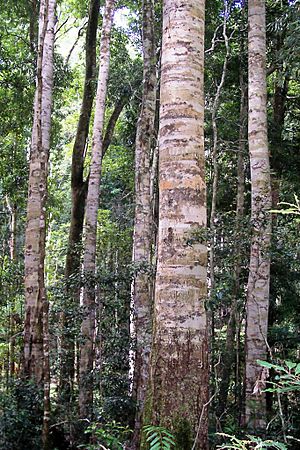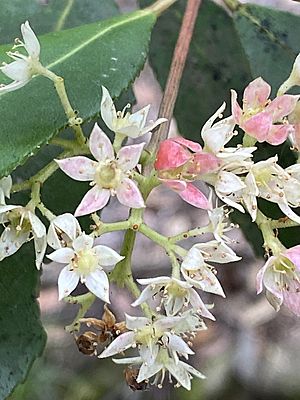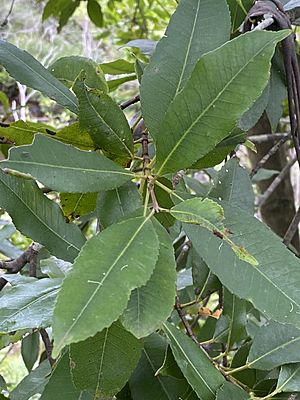Coachwood facts for kids
Quick facts for kids Coachwood |
|
|---|---|
 |
|
| Coachwood at Nymboi-Binderay National Park | |
| Scientific classification | |
| Genus: |
Ceratopetalum
|
| Species: |
apetalum
|
| Synonyms | |
|
List
|
|
The Coachwood (also known as scented satinwood or tarwood) is a special kind of tree. Its scientific name is Ceratopetalum apetalum. This medium-sized hardwood tree grows straight and has smooth, greyish bark that smells nice.
You can find Coachwood trees in eastern Australia. They grow in the central and northern coastal rainforests of New South Wales and southern Queensland. These trees often like to grow in gullies and creeks, even in poorer soils. Sometimes, you'll see many Coachwood trees growing together in one area. There are 8 types of Ceratopetalum trees found in eastern Australia and nearby islands.
Contents
What Does a Coachwood Tree Look Like?
Coachwood trees usually grow to about 25 metres (82 feet) tall. Their trunks can be around 90 centimetres (3 feet) wide. Some very old and large Coachwood trees can reach an amazing 40 metres (131 feet) tall! These giant trees can live for hundreds of years.
The trunk of a Coachwood tree has unique horizontal marks or scars. These marks often go all the way around the trunk. Older, larger trees might have short buttresses, which are wide, flat roots that help support the tree.
The Wood of the Coachwood Tree
The wood from the centre of the tree, called the heartwood, is very pretty. It can be a pale pink or a pinkish-brown colour. The outer wood, called sapwood, often looks similar, so it's hard to tell them apart.
Coachwood timber has a straight, fine, and even texture. If you look at the wood from the side, it often has beautiful patterns. One of the coolest things about Coachwood is its smell – it has a distinct caramel scent!
How Was Coachwood Named?
The scientific name Ceratopetalum apetalum was first officially written down in 1830. This was done by a person named David Don. He described the tree from samples collected by George Caley.
The common name "coachwood" comes from its history. People used this wood a lot to build coaches in the past.
What Is Coachwood Used For?
Coachwood timber is popular because it's light and easy to work with. This means it's simple to cut, shape, and build things from it.
People use Coachwood for many different items, such as:
- Flooring in homes and buildings
- Making furniture and cabinets
- Interior decorations and fittings
- Turnery (items made by shaping wood on a spinning machine)
- Parts of gun stocks
- Wood carving projects
- Making thin sheets of wood called veneers
- Building spars and masts for boats
A great example of Coachwood's beauty is in courtroom number three of The High Court of Australia. This entire courtroom is beautifully furnished with Coachwood timber.
See also
 In Spanish: Palo satinado para niños
In Spanish: Palo satinado para niños



